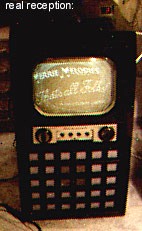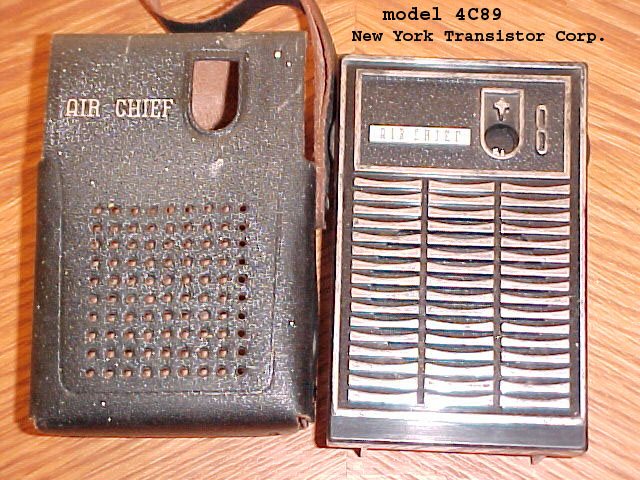Radios A thru E
This is an Admiral AA6 tube 6T01-6A1 chassis in a wooden cabinet meant for an Admiral AA5 tube radio
6T04-5B1. The 6A1 chassis uses a variable inductor to tube the output of the RF stage, and a variable 2 gang capcator for the
antenna circuit and the local oscillator.





Replaced the wax caps and the filter electrolytics in the 6A1 chassis before even powering it up. And
found that a 12SH7 sharp cutoff tube works better than the 12SJ7 it calls for. Needed to retune the
antenna cap trimmer a little. Just above is a closeup of how the variable inductor that tunes the output
of the RF amplifier was done. A spring loaded arm rests against a cam attached to the tuning dial drum
that also tunes the variable cap. The shape of this cam was designed to control the arm, which in turn
moves the ferrite bar in and out of the coil. This shape was made to have the tuning of this coil track
what the variable cap for the antenna circuit is tuning. It's possible, back in the day, Admiral couldn't
obtain 3 gang tuning caps but still wanted to make a radio with an RF stage. And someone designed
this workaround. Which actually works quite well.
Here I replaced the RF stage that was a 12SH7 with a 5899 submini tube, a semi-remote cutoff pentode.
I stuck an 8 pin submini tube socket into the center hole of the octal socket, and wired the
corresponding pin functions to the octal terminals below deck. The octal socket became a terminal strip.
Works well. I added a shield around the tube, connected
to one of the tube's cathode pins. And a center shield in the submini socket was also connected to ground,
for more shielding the input from the output. I also did this with the IF stage. That stage ended up with
too much gain, so I lowered it with a 100K resistor in parallel with the output LC of the 2nd IF
transformer (plate to B+). These tubes each need only 6.3V in the heater string (current
is 150ma) so I changed the 35L6 to a 50L6 (the two 6.3V submini tube heaters look like a single 12V, and
thus the heater string looks like a typical AA5).



Right: an Admiral AA4 
Australia:  The AWA is quite similar to an AA5, except for the use of a power transformer. Internal loopstick antenna.
The AWA is quite similar to an AA5, except for the use of a power transformer. Internal loopstick antenna.
A transistor radio: 
 No, it's solid state:
No, it's solid state:


.

Apex AD3201.
This DVD player has a hidden menu.
To access:
Eject the tray, then press the numbers 8, 4, 2, then 1
on the remote. Dashes should appear on the screen for
the first 3 numbers, then the hidden menu should then appear
upon pressing the last number. Use the ^ and v keys on the
remote to select "region" or "macrovision". Use "enter"
to step thru which region you want (9 is "all" or "bypass") and if you want macrovision
or not. Macrovision may make some vintage TVs or VCR channel modulators unhappy.
To save the settings, close the disc tray. You can use the "Y" video output
to feed a B&W TV set, as it will not have the color subcarrier on it.

 Airline 83BR-502. No logo anywhere on this radio.
Superheterodyne without an IF stage, 300ma heater string with ballast.
Airline 83BR-502. No logo anywhere on this radio.
Superheterodyne without an IF stage, 300ma heater string with ballast.
The Belmont transistor on the left is a typical superheterodyne set.

This Airline 62-508 radio is a superheterodyne with 150ma heater string tubes.



My brother and I had an Admiral B&W TV set just like this one
(model 24R12) back
in the '60's when we were kids. Diagram
 An Admiral FM only radio
An Admiral FM only radio



Not related to Firestone.

 This radio has my name on it!
This radio has my name on it!  model: 010
model: 010
Not collectable yet! with 8 track 



An Australian MW radio set, circa late 1960's: Calstan

Closeup of the above dial with Australian radio station callsigns:

A tube AM/FM stereo tuner someone glued a "Sony" logo over the
"Claricon" logo.


The AM section is just like that of an AA5, but the FM is pertty good.
I made the FM a little more sensitive by changing the last two FM IF tubes from
6AU6's to 6DE6's (twice the transconductance). Also did that to the AM
IF (6BA6 to 6DE6). This was done after I did a first realignment, so I
did really see improvement after a 2nd realignment.

 A car radio (on the right) using 12V B+
space charge tubes.
A car radio (on the right) using 12V B+
space charge tubes.
 Another, tag said it's for a 1960 Oldsmonile
Another, tag said it's for a 1960 Oldsmonile
 This one is all transistorized. Note the conelrad
D
markings.
This one is all transistorized. Note the conelrad
D
markings.
DeWald model A500
 And a model C-800 AM-FM
And a model C-800 AM-FM 


My first stereo receiver, bought in 1972. If you have one of these or similar, and it
doesn't work that well, you may need to replace the electroytic caps.
I had to replace nearly all of them to get mine to
work again. While I was in it, I replaced all of them. One or two were leaking the secret sauce
onto the board.


Standard hifi web site shot to make it look impressive, though I'm sure noone is
fooled. As it's actually quite modest inside.
I think it makes only a couple watts of output power. But that's okay, as I don't blast my music.
 this one in 1996
this one in 1996
Vacuum tube stereo amp 
Less hum in the phono preamp if the 12AX7s are replaced
with 7025s.

This should be in the E section, but there's some leakage in this web site










 The AWA is quite similar to an AA5, except for the use of a power transformer. Internal loopstick antenna.
The AWA is quite similar to an AA5, except for the use of a power transformer. Internal loopstick antenna.

 No, it's solid state:
No, it's solid state:




 Airline 83BR-502. No logo anywhere on this radio.
Superheterodyne without an IF stage, 300ma heater string with ballast.
Airline 83BR-502. No logo anywhere on this radio.
Superheterodyne without an IF stage, 300ma heater string with ballast.



 An Admiral FM only radio
An Admiral FM only radio



 This radio has my name on it!
This radio has my name on it!  model: 010
model: 010






 A car radio (on the right) using 12V B+
space charge tubes.
A car radio (on the right) using 12V B+
space charge tubes.
 Another, tag said it's for a 1960 Oldsmonile
Another, tag said it's for a 1960 Oldsmonile
 This one is all transistorized. Note the conelrad
D
markings.
This one is all transistorized. Note the conelrad
D
markings.
 And a model C-800 AM-FM
And a model C-800 AM-FM 




 this one in 1996
this one in 1996

